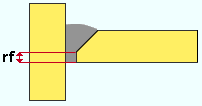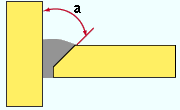 Chamfer Edge Command
Chamfer Edge Command
- Step-By-Step
- Undo
- Tips and Tricks
- Related Tools
1. Before using this tool:
1a: Go to an isometric view that shows the length, width and depth of the desired chamfer operation.
2. Preselect a material to enable the Materials contextual page and click the Chamfer Edge icon found in the Operations section. Skip step 3.
Alternative: Invoke Chamfer Edge using the Find Tool by searching the command name and clicking the Chamfer Edge icon, which is pictured above. Proceed to step 3.
Learn more about alternative methods for launching commands.
3. Skip this step if you already selected a material in step 2.
3a: Chamfer Edge gives you Select One Item mouse bindings and prompts you to Select material. This prompting also occurs if a member, bolt or weld (rather than material) was selected before invoking the command.
|
|
|
Select One Item bindings |
4. (if HSS) If the material you selected is an HSS rectangular (tube) or HSS round (pipe), a window opens that lets you set whether you want to be allowed to select the Outside or Inside or Both edges in step 5.


|
|
The highlighting of selectable edges that you get in step 5 (the next step) when you select Outside or Inside or Both in this step (step 4). |
5. The color of the material edges changes to the Selectable edge color found in User and Site Options. Locate - Pan - Menu mouse bindings become active. The status line prompts, "Locate edge(s)."
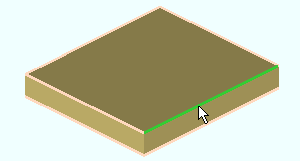
|
|
5a: Left-click (Locate) each of the edges you want to chamfer. As you hover an edge, it changes from the Selectable edge color setting to the Selectable edge highlighting color. Once selected, edges change to the Primary selection surface selection color.
5b: Press the Enter key or right-click (Menu) and choose OK on the context menu to signal to Chamfer Edge that you are done selecting edges.
6. The Edge Chamfer window opens. Enter a Root face and a Chamfer angle.

Root face: The length (in the primary dimension Units or other units) of the material edge(s) that you do not want to chamfer.
rf = root face Chamfer angle: The number of degrees that is the angle of the bevel.
a = chamfer angle Alternative 1: Press OK to go to step 7.
Alternative 2: Press Cancel to end this operation without chamfering the edge of the material. Do not continue.
7. Chamfer Edge shows the material edge as chamfered. The status line prompts, "Verify chamfer." Yes - No mouse bindings become active.
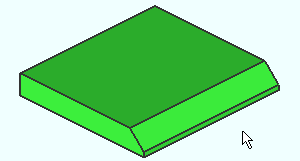
|
|
Alternative 1: Left-click (Yes) to accept the edge chamfering that is shown. Go to step 8.
Alternative 2: Right-click (No) to end this operation without chamfering the edge. Do not continue.
8. The Change All Options window opens. On it is the message: Material will be chamfered.

Alternative 1: Make the appropriate selections on this window, then press the OK button at the bottom of the window to regenerate the material.
Alternative 2: Press the Cancel button to end this operation without chamfering the edge.
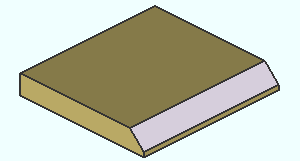
|
|
a plate with a chamfered edge. |
Method 1:
1. Open the material's edit window (e.g., double-click the material, or hover the material and right-click (Menu) and choose Edit Other on the context menu).1a: Press the Material Operations button at the bottom of the material edit window.
2. A dialog opens showing each of the material operations that appear on this material.
2a: Check the Delete check box next to the operation you wish to delete. If you want to delete multiple, you can select more than one. If you wish to remove all operations, select the Delete All check box.
2b: Press the Close button at the bottom of the Material Operations window.
2c: Press the OK button at the bottom of the material edit window.
3. The Change All Options window opens. On it is a Warnings list and Options.
3a: Optionally select the Options you want, then press the OK button.
4. The material is regenerated per the settings on its edit window. In other words, the material operation with the delete check box checked disappears.
Note: If other pieces with the same submaterial piecemark exist in the 3D model and you selected the appropriate Options, then other materials are also regenerated as specified on the edit window.
Method 2:
1. In the view in which you want to remove the material operation, display in solid form all members that you want to edit.
Alternative 1: View > Solid Opaque to display in solid form the members that you want to edit.
Alternative 2: View > Change All to Solid to display in solid form all members that are in the view.
2. Select the material operation by doing the following:
Alternative 1: Run the Show Material Operations tool if they are not shown. Once the material operation is shown you can select it.
Alternative 2: Using the Model Tree, expand the member and material subclasses, and select the Chamfer edge operation.
3. Once the Chamfer edge operation is selected, do the following to delete the operation:
Alternative 1: Select the Delete key on the keyboard.
Alternative 2: Select the Delete
icon.
- The Material Operations window
- Chamfer Point to Point (tool that can be used to chamfer part of an edge)
- Perform chamfer (Edit Weld window)
